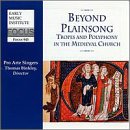| All Artists: Anonymous, Gregorian Chant Title: Beyond Plainsong: Tropes and Polyphony in the Medieval Church Members Wishing: 0 Total Copies: 0 Label: FOCUS Release Date: 9/22/1995 Genres: Special Interest, Pop, Classical Styles: Vocal Pop, Opera & Classical Vocal, Chamber Music, Historical Periods, Early Music Number of Discs: 1 SwapaCD Credits: 1 UPC: 786031094323 |
Search - Anonymous, Gregorian Chant :: Beyond Plainsong: Tropes and Polyphony in the Medieval Church
 | Anonymous, Gregorian Chant Beyond Plainsong: Tropes and Polyphony in the Medieval Church Genres: Special Interest, Pop, Classical
|
Larger Image |
CD Details |
CD ReviewsA beautiful piece of musical history FrKurt Messick | Bloomington, IN USA | 10/13/2005 (5 out of 5 stars) "One of the glorious aspects of living in Bloomington, Indiana, is being close to the music school, one of the better music schools in the world. Because of this, there is never a time when a rich fare of musical offerings is not available, and one of the more wonderful of these is the Early Music Institute, which has an annual conference/series of performances, and supports many ancient and medieval music enterprises.
One of these is the Pro Arte Singers, under the direction of Thomas Binkley. He also plays the lute on this recording, with Wendy Gillespie on the vielle. The singers on this recording include Elisabeth Honn, Kelly Landerkin, David Meyer, Amanda Simmons, David Stattelman, Susannah Teegarden, and Jay White. Their singing is absolutely wonderful, and their performance is in one of the local churches in Bloomington (First Baptist Church) rather than a studio (churches in Bloomington are often used in by music school performers for concerts and recitals, as well as recording sessions). The most dominant form of music in the early Middle Ages was plainchant. According to scholar Patrick Kavanaugh, 'there are no parallels to chant in the history of music in terms of longevity, importance or influence.' There has been a resurgence of interest in chant in the past decade, but as often as not, what people are being drawn to is not technically chant. This recording shows developments that came after chant - the introduction of polyphony (multiple voices or tones) as opposed to the monophonic nature of chant was very important, and led in diverse ways to the various styles of Western music. The music recorded here is just a step away from plainchant, with simple polphonies and tropes. 'In the Medieval era, troping was an important compositional technique. There were two basic types of tropes: textual and musical. A textual trope involved the assigning of a new text to an existing musical melisma. A musical trope was the insertion of new notes into a piece of music, creating or extending a melisma.' This is a wonderful piece of history, and a beautiful performance. " |

 Track Listings (16) - Disc #1
Track Listings (16) - Disc #1